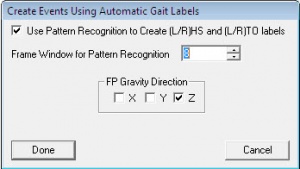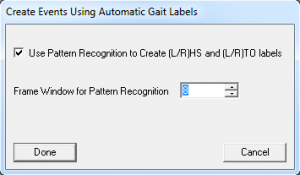Automatic Gait Events
| Language: | English • français • italiano • português • español |
|---|
Gait Events can be created automatically if Force Platform assignments exist. Note that in order to create Events for both the RIGHT and LEFT sides, there must be assignments for both feet (or hands) on force platforms.
In addition, the model must have segments created so that Visual3D can recognize left from right. For example, a right foot segment and a left foot segment must be created before running the automatic gait command. Secondly, the segment in contact with force platform does not have to be a foot segment. If a hand segment, for example, makes contact with the force platform, this segment would be used to create the events.
Other contacts with the floor for which there are no force platforms can be determined using TPR. Selecting this box will cause Visual3D do determine these other events. No signals need to be provided for the TPR because for this command Visual3D uses the segment kinematics of the segment making contact with the force platform.
Pipeline Command
The dialog (on left) pops up when pipeline selection is edited by double clicking with the left mouse button.
Prior to version 5:
Automatic_Gait_Events ! /SELECT_X=FALSE ! /SELECT_Y=FALSE ! /SELECT_Z=TRUE ! /FRAME_WINDOW=8 ! /USE_TPR=TRUE ; |
Post version 5:
In version 5, and update was added to the Automatic_Gait_Events command so that users no longer need so specify the direction of gravity, as Visual3D can determine this internally. Please note that the event detection algorithm has remained unchanged.
Automatic_Gait_Events ! /FRAME_WINDOW=8 ! /USE_TPR=TRUE ; |
Gait Event Acronyms
Definitions of the gait event acronyms used in Visual3D
The automatic gait events command and many of the events created in the tutorials, and used in the example files have 3 (or 4) character labels that have been used consistently albeit cryptically. These acronyms are historical and derive from the early versions of software that read C3D files because the original C3D format allowed a maximum of characters for an Event Label.
These Event labels are divided into two categories:
1. The kinematically based categories include:
- RHS= Right Heel Strike
- RTO= Right Toe Off
- LHS= Left Heel Strike
- LTO= Left Toe Off
2. The kinetically based categories refer to those events that describe contact with a force platforms:
- RON= Right On
- ROFF= Right Off
- LON= Left On
- LOFF= Left Off
All RON events are also RHS events, but RON events are only created when contact is made with a force platform. This provides a means to declare a range of data for reporting only when in contact with the force platform because Joint Moments and Joint Powers for example to not have meaningful data when the foot is in contact with ground but no ground reaction forces are measured.
Outline
If force platforms exist in a dynamic trial, the Automatic_Gait_Events pipeline command can be used to create gait events. ON/OFF events indicate kinetic cycles and HS/TO indicate kinematic cycles.
- A static trial must be loaded into the workspace and a minimum of two segments must be created (for standard gait trials, this means a left/right foot segment must be created).
- If a force platform assignment exists in a dynamic trial, ON/OFF events will be created when Force Assignments exist. A Force Assignment exists IF:
- A segment’s center of mass (ANY segment) falls within the specified distance between center of force pressure to segment.
- The force signal goes above the specified minimum force platform value.
- A segment’s center of mass (ANY segment) falls within the specified distance between center of force pressure to segment.
- If “Use Pattern Recognition to Create (L/R)HS and (L/R)TO labels” is checked, and if an ON/OFF event was created in a trial, a HS/TO event will be created in the trial based on the position of the foot segment: (See Event_TPR_Signal section for more information on this)
- HS events will be created based on the Axial and AP position of the proximal end of the foot
- TO events will be created based on the Axial and AP position of the distal end of the foot
- HS events will be created based on the Axial and AP position of the proximal end of the foot
Event_TPR_Signal
A description of the use of Event_TPR_Signal for determining gait events when a force platform signal is present is presented in the following article.
Stanhope SJ, Kepple TM, McGuire DA, Roman NL.(1990) "A Kinematic-Based Technique for Event Time Determination During Gait." Medical and Biological Engineering and Computing 28:355-360.
Event_TPR_Signal for the Automatic Gait algorithm uses the Axial and AP trajectory of the proximal end of the foot segment for detecting Heel Strike. In other words it uses the signal KINETIC_KINEMATIC::RFT::ProxEndPos and KINETIC_KINEMATIC::LFT::ProxEndPos
Event_TPR_Signal for the Automatic Gait algorithm uses the Axial and AP trajectory of the distal end of the foot segment for detecting Toe Off. In other words it uses the signal KINETIC_KINEMATIC::RFT::DistEndPos and KINETIC_KINEMATIC::LFT::DistEndPos
The HS and TO pattern recognition algorithms are not a generic one size fits all gait recognition algorithm, but rather it looks at the first ON and OFF events and matches the subject's specific pattern at the heel and toe to find other instances of the subject/trial specific pattern within a trial. The algorithm works very well, but if the pattern changes within a trial then the different HS or TO may not be identified.
Gait events when no Force Assignments exist
While it is preferably to use force assignments to compute automatic events, there are times when this isn't possible. Computing gait events from kinematic data is not particularly reliable, but if this is the only choice...
Visual3D Versions supporting Subject Prefixes
When defining events for subjects that use a prefix to define the data belonging to that subject, event labels will also have the prefix of the subject the events belong to.
NOTE: When using events in a command, the commands will iterate across subjects contained in the current workspace. As such, events and sequences listed as command parameters should NOT contain a prefix. As each subject is processed, the event range/sequence specified will automatically use the specific events prefixed for each subject as they are processed.
Visual3D Version 4 Changes
Assignment of segments to forces is a bit tricky; partly because it has been re-implemented in Version 4.0 for real-time. The new decisions have trickled down into post-processing.
in Version 4 and above:
There is an option in Visual3D to threshold force signals, so that all values below the threshold are set to zero. If the force is zero, the center of pressure doesn't exist. This allows us to check the center of pressure and ignore the magnitude of the force.
The automatic segment assignment compares the path of the center of mass of each segment to the center of pressure, and assigns the segment with the smallest value (within a minimum distance; also set under the properties menu).
This strategy was adopted to accommodate force structures (one example of which is simultaneous contacts on multiple platforms), but there are many other force structures buried in Visual3D now.
In previous versions:
the user had control of the magnitude of the threshold, but this often led to inconsistencies between the assignments and the events, which caused some strange spikes in the data in early versions. We elected to avoid this inconsistency.
Visual3D does not provide a command for determining gait events automatically when no force platform data or foot switches exist in the data file. After considerable testing of various algorithms, we decided that there was no reliable method for determining the events, especially for pathological gait.
We recommend that the user determine one occurrence of left and right heel strike and toe off manually. This can be done once per subject (e.g. once in one of the movement trials). The TPR_Signal command can then be used to estimate all other occurrences.

